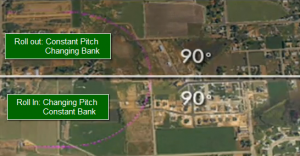Previous lesson, division of attention.
Introduce chandelle maneuver. Allow the student to explain and perform the maneuver. Used to develop coordination, orientation, planning, and feel for maximum performance flight and to develop positive control techniques at varying airspeeds and attitudes.
The maneuver was used by early fighter pilots in their low powered aircraft to quickly turn toward a pursuing attacker. http://en.wikipedia.org/wiki/Chandelle
It is also useful for the precarious flying into a narrow canyon: never do that.
Read AFH & watch Chandelle Maneuver Video
§61.125(b)(13), 61.127(b)(5) AFH 9-4; Area of Operation V, Task C
Commercial Maneuvers: Chandelle
Definitions:
Chandelle: a climbing turn from straight and level and ending at the completion of a 180° at wings level, nose-high attitude at MCA: minimum controllable airspeed (just above stall speed).
Preflight Briefing:
Select starting altitude at least 1500 ft AGL, and perform clearing turns behind and above you. The configuration is clean, trimmed/stabilized in level flight for cruise, and configured for a climb.
Mentally divide the turn into two 90° sections:
Use aileron and rudder to start a coordinated turn to 30° bank. As you reach 30° bank, simultaneously add full power and gradually increase pitch to maintain a smooth, coordinated, climbing turn to the 90° point with a constant 30° bank angle. Pitch should be smoothly increasing to be half way between your previous cruise speed and the ending MCA.
At the 90° point, begin a smooth constant rate rollout while maintaining a constant pitch attitude. As airspeed slows, increasing back elevator pressure is required to maintain this constant pitch. Bank angle should be constantly (but slowly) decreasing as you roll out on your 180° heading. 2nd half of turn doesn’t need to be as fast as the first 90° half.
The left chandelle requires more right rudder to maintain coordination, due to:
- Decreased air over the rudder
- P-factor (left turning tendencies:
- High pitch attitude
- Torque (high rpm)
- Left aileron lowering (to level the wings) will produce extra drag, pulling the wing backward (increased induced drag); or a yaw to the left.
Recover from MCA by slowly releasing back pressure as the airspeed builds, while maintaining the final rollout heading, without losing altitude.
Common errors: incorrect use of rudder, maintaining constant pitch attitude in 2nd half of turn, (and others as listed in AFH)
Special Emphasis Areas: Maintain coordinated flight at all times.
Divide attention between instruments and outside the aircraft.
Completion Standards: Commercial PTS: establish 30° bank at beginning of maneuver, rolls out +/- 10° heading, at an airspeed just above stall speed (maintaining briefly), but avoiding a stall, and resumes straight and level cruise flight with minimum loss of altitude.
Flight phrasology:
- 30° Bank, then slowly increase pitch (first 90°)
- Maintain pitch, slowly decrease bank (last 90°)
Post-Flight Debriefing:
Identify tasks that were completed to standards or above.
Identify and discuss tasks that were not completed to standards.
Record and grade completed tasks in the training record.
Record training in the student’s logbook (reference Areas of Operation above)
Give an assignment for the next flight session.
Next Assignment: Prepare for completing this lesson by reviewing tasks that were not performed to standards. If all tasks were performed to standards, assign the next lesson’s required material.
